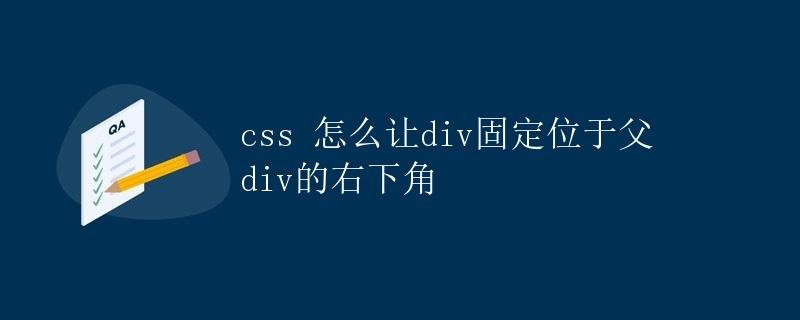How to fix a div in the lower right corner of the parent div using CSS
How to use CSS to make a div fixed at the bottom right corner of its parent div
 In web page layouts, it’s sometimes necessary to pin a Div element to the bottom right corner of its parent Div. This layout is often used to display fixed content, such as a back-to-top button or online customer service. This article will introduce several methods for achieving this layout, including absolute positioning, flex layout, and grid layout.
In web page layouts, it’s sometimes necessary to pin a Div element to the bottom right corner of its parent Div. This layout is often used to display fixed content, such as a back-to-top button or online customer service. This article will introduce several methods for achieving this layout, including absolute positioning, flex layout, and grid layout.
Method 1: Using Absolute Positioning
Absolute positioning is a common layout method that allows elements to be positioned outside the document flow, relative to their parent element. Here’s a simple example code demonstrating how to use absolute positioning to pin a div to the bottom right corner of its parent div:
<!DOCTYPE html>
<html lang="en">
<head>
<meta charset="UTF-8">
<meta name="viewport" content="width=device-width, initial-scale=1.0">
<title>Div fixed to the bottom right corner</title>
<style>
.parent {
position: relative;
width: 300px;
height: 200px;
border: 1px solid #ccc;
}
.child {
position: absolute;
bottom: 0;
right: 0;
width: 100px;
height: 50px;
background-color: #f00;
}
</style>
</head>
<body>
<div class="parent">
<div class="child"></div>
</div>
</body>
</html>
In the example above, we set the position: relative;, and then set the child div to position: absolute; bottom: 0; right: 0;. This will anchor the child div to the bottom right corner of the parent div.
Method 2: Using Flex Layout
Flex layout is a flexible layout method that can easily achieve a variety of complex layout effects. Here’s an example using flex layout to pin a div to the lower right corner:
<!DOCTYPE html>
<html lang="en">
<head>
<meta charset="UTF-8">
<meta name="viewport" content="width=device-width, initial-scale=1.0">
<title>Div Pinned to the Lower Right Corner</title>
<style>
.parent {
display: flex;
justify-content: flex-end;
align-items: flex-end;
width: 300px;
height: 200px;
border: 1px solid #ccc;
}
.child {
width: 100px;
height: 50px;
background-color: #0f0;
}
</style>
</head>
<body>
<div class="parent">
<div class="child"></div>
</div>
</body>
</html>
In the above example, we set display: flex; justify-content: flex-end; align-items: flex-end; on the parent div, which will cause the child div to be fixed to the lower right corner of the parent div.
Method 3: Using Grid Layout
Grid layout is a two-dimensional layout method that can easily achieve various complex grid layout effects. Here’s an example code that uses a grid layout to pin a div to the lower right corner:
<!DOCTYPE html>
<html lang="en">
<head>
<meta charset="UTF-8">
<meta name="viewport" content="width=device-width, initial-scale=1.0">
<title>Div Pinned to the Lower Right Corner</title>
<style>
.parent {
display: grid;
place-items: end end;
width: 300px;
height: 200px;
border: 1px solid #ccc;
}
.child {
width: 100px;
height: 50px;
background-color: #00f;
}
</style>
</head>
<body>
<div class="parent">
<div class="child"></div>
</div>
</body>
</html>
In the above example, we set display: grid; place-items: end end; on the parent div, which will cause the child div to be fixed to the lower right corner of the parent div.
Using the above three methods, we can achieve a fixed div position at the lower right corner of the parent div. Choose the appropriate layout method to achieve this effect based on your actual needs and layout complexity. I hope the above content is helpful!